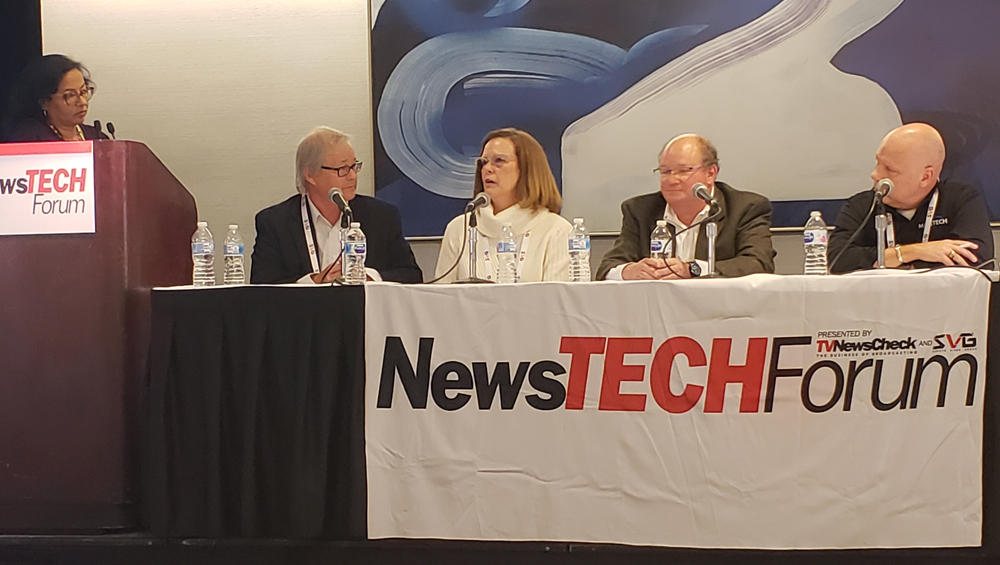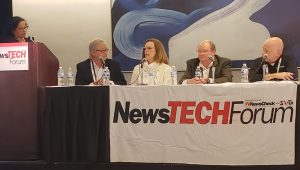
Metadata Is Key To Improved News Workflow

More efficient use of metadata is key to both improving broadcasters’ everyday news workflows and better utilizing — and perhaps monetizing — their heaps of archived content, according to top technology executives Tuesday at TVNewsCheck’s NewsTECHForum in New York.
Hank Hundemer, SVP of engineering for Tribune Broadcasting, has been riding with news crews recently to find “their pinch points” and figure out ways to help. He says metadata is a prime focus.
“We are in a position where we are serving so many platforms and masters, that the reduction in friction in the workflow is really critical.”
So, the question becomes how can you generate metadata easily and without a lot of work, says Hundemer. “I want to reduce the friction. Sometimes the crews are getting so frustrated. They have the story, they have the video, they have the data, and there is some impediment in the way.”
Hundemer, who was speaking on a panel, “Top Technologists on the Bleeding Edge,” moderated by consultant Andrea Berry, CEO of The G.A.P. Media Group, has devised a simple way to generate more metadata from field crews.

L-r: Moderator Andrea Berry, Graham Media’s Michael Englehaupt, ABC’s Tish Graham, Tribune’s Hank Hundemer, Masstech Innovation’s Mike Palmer. (Photo: Jill Altmann)
He’s installed a Bluetooth dock under the seat of news vans, set to a very low power, so that when a journalist leaves the van his or her smartphone automatically disconnects from the network. Those Bluetooth connections and disconnections provide an activity log that can be reconciled later against recorded video and location data.
“When the guy’s phone disconnects from that dock, he’s getting out to shoot something,” says Hundemer. “So then when the video comes back in, you can ask him what is this video, did you shoot it at one of these locations? So you’re lowering the friction associated with getting a right answer.”
Reducing friction in the news workflow is also a top priority for the ABC Owned Television Stations Group, says VP of Broadcast Technology Tish Graham, particularly as ABC expands its OTT and digital efforts.
“I talk about it as moving content across all of our platforms like water, so the end user doesn’t care where it is, or how it gets from point A to point B,” says Graham. “Whether it needs to be a linear piece, or it needs to be OTT or some type of digital piece, we need to build the backend systems and automate them as much as possible to be able to move that content wherever it needs to go, and to be reliable — not just across an individual station, but across the entire group.”
Graham had breakfast with her ABC colleagues this week and says the subject of metadata kept popping up. “We have to draw a line in the sand, starting today — or some of us, starting a year ago — to get as much metadata as you possibly can onto content you’re producing now, for monetization later, to be able to find things, especially for an OTT play, or any kind of digital play,” she says. “Any kind of information you have on that clip is just so important.”
Archives are a different story. ABC stations have archives that are 30 and 40 years old and there is no metadata on that content. So, Graham is investigating cloud technologies as a way to begin generating it.
“You’ll hear many people say you’re sitting on a goldmine,” says Graham. “We may be sitting on a goldmine, but we have no idea what we’re sitting on. But the technology is there now to run speech to text, and to start to figure out what do we have, what can we use, what do we have rights to, what do we not have rights to? Ten years ago, none of us thought about metadata or digital rights. But now it’s front and center of what we do.”
Mike Palmer, CTO of storage management vendor Masstech Innovations, sees many broadcasters wrestling with the question of how to manage content across their archives. In many cases, customers have content stored across multiple locations with a mix of technologies including LTO (linear tape optical), ODA (optical disc archive), public and private clouds.
“The challenge there is how do you make that content discoverable, and once you’ve got it discoverable, how do you move the essence and the metadata?” says Palmer.
“Because what we talk about now is, the metadata is just as important as the essence. How do you make that move across the organization like water? Maybe it’s as a service, so you can choose the applications that fit you best.
“So for instance, providing search across the organization as a service, so you can plug Avid or Grass Valley on top of that, and they don’t have to worry about the details of where things are stored or how they get from Point A to Point B.”
Palmer adds that metadata is not only essential to find content in an archive or to direct OTT distribution. It can also be used adroitly to lower overall storage costs by directing the “lifecycle management” of a piece of content.
“Ninety percent of the archive is probably never going to be used; the 10% that does has to justify the cost of everything else,” he says. “You really have to look at how much money you’re spending on that archive. If it’s in the cloud it becomes very obvious because it’s an operational model there.
“But it’s how much are you spending versus how much are you bringing back. This really leads you into a discussion of what bit rate do I store things [at], and how can I get the cost of that storage down? If the cost of the storage is pretty much fixed, how can I make the file sizes smaller, and when do I do that? And you do that based on the metadata you have associated with the content. So the more metadata you have, not only is your content more likely to be sold, but it’s also more likely to be compressed and cheaper to store over time.”
While artificial intelligence (AI) is likely to come in handy for sifting through content archives, it has a more pressing application in broadcast stations today — closed-captioning, says Graham Media VP and CTO Michael Englehaupt.
“One of the weak knees in every TV station is closed captioning. And we all have issues with closed captioning. It’s a big target on our back, where the [FCC] will, without too much hesitation, throw out a fine, a hefty one, if you don’t provide captions that are legible and credible. So what do we do as stations?”
Englehaupt notes the choices are relatively cheap hardware-based speech-to-text solutions that sit internally in a station, or outsourcing it to a higher-quality captioning provider. With the advent of cloud-based, AI-driven services, he thinks stations can now afford to do both.
“You can buy the box and sit it in a rack and it becomes an asset, and then you can supplement that with a [IBM] Watson-driven solution that becomes an opex process,” he says. “I think that’s a great opportunity for stations to rethink how they are doing captions right now.”
Here is the link to the video of this session: https://www.youtube.com/watch?v=MoakxHOUrjg
Read all our NewsTECHForum coverage:
IP Tools Complement Old Favorites In TV News
To Win At OTT, Think Programming
OTT Is Top-Of-Mind For CBS’s Christy Tanner
Journalists Bring Digital Aesthetic To Local News
NBC Stations’ Staab Underscores Localism, Tech
How Broadcasters Can Reach Young Viewers
































Comments (1)
tvn-member-9348876 says:
December 18, 2018 at 11:53 am
This idea that stations are sitting on gold mines is an interesting one to explore. In the 1970’s I visited the ghost town of Calico in the Mohave Desert. At the entrance to the old silver mine was a huge pile of dirt and rock that had been excavated from the mine. According to the tour guide, there was more then one million dollars in silver ore in the pile but it would cost more then five million to extract it. It seems like our libraries are like that mound that at one point in time was too expensive to extract but now thanks to technological advancement, the costs are more reasonable and market demand has made the product more valuable. I also wonder if the price of silver has made the mound in Calico disappear…I may have to go back and visit again.